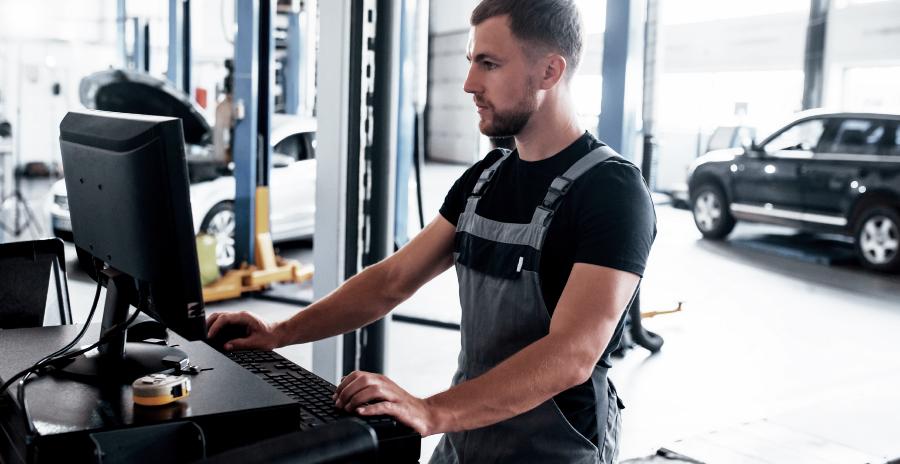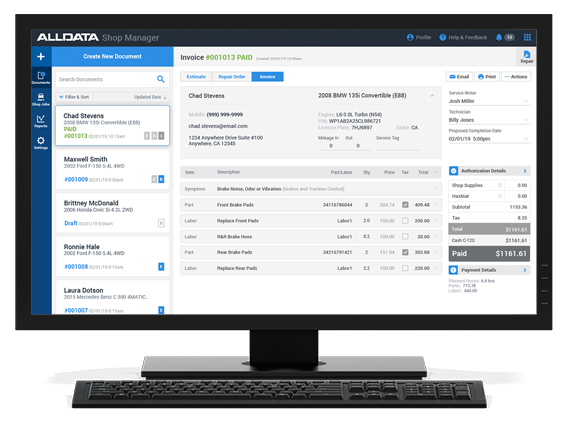

TOP THREE WAYS TO BOOST YOUR BUSINESS
Over the past few months, the automotive industry has experienced challenges unlike any we’ve seen before. With the onset of COVID-19, customers stopped calling, parts stores experienced disruptions in their supply chains and shop owners throughout the nation were wondering if they were going to close their doors for good.
More importantly, used car sales in May 2020 grew 105% over April 2020. Since used car sales is a primary driver of independent repair shop business, this upturn in sales is a good sign that business will soon be returning to normal.
The COVID-19 pandemic may have altered the way the entire automotive industry operates, but we are a resilient group and will find a way to come out on top. Although used car sales dropped in April 2020 to 38.4% over the same period in 2019, the year-over-year sales in May 2020 improved by 12.5%. More importantly, used car sales in May 2020 grew 105% over April 2020. Since used car sales is a primary driver of independent repair shop business, this upturn in sales is a good sign that business will soon be returning to normal.
Despite optimistic predictions by many industry experts, dealership and independent shop owners are still holding their collective breaths; anxious to see what the future will hold. Many independent shop owners I spoke with recently said that they have remained open during the pandemic and geared up to comply with current health and safety guidelines.
Although some were quick to say that their profits were down anywhere from 5% to 48% from the same time last year, all were grateful to retain their employees and keep the doors open. I was interested to hear that many shop owners took the slow times to find ways to overcome some of the challenges they were already facing before the pandemic hit. In this article, I’d like to share the top three shop improvement ideas you may want to implement now so you can emerge from this crisis even stronger than ever.
Create a Social Media Presence
In addition to creating and maintaining a dynamic shop website, you may want to set up social media accounts for your shop (Examples: Facebook, Twitter, Google Business, Yelp). The main reason to do so is because, other than the time it takes you to set up an account and maintain it, it’s free and effective advertising! Why spend money on yellow page ads?
Yes, it will take some time and skill to be good at it, but the returns on your efforts are tremendous. Social media sites also have paid advertising options that will target specific audiences, automate posts or track the effectiveness of your ad campaigns, but the basic site features will meet the needs of most shops.
One shop owner I spoke with, Adam Inocelda of A & J Automotive in Rancho Cordova, California, said that he and his brother Jon use multiple social media sites to promote their shop. Adam said, “The trick to getting your shop to the top of the search results page on any of these sites is to have a large number of reviews and a high star rating. It means your shop is more relevant than shops with fewer reviews.” Adam went on to say that they offer customers a 5% discount on their next service if they leave a review. He also mentioned that the social media sites make it very easy to get information about your shop out to your current and potential customers. Just be sure to provide valuable information in your posts, not just promotions.
Because it is currently how many people interact, Facebook gives you instant visibility and access to a massive pool of people in your community and beyond. With Facebook, you can engage more efficiently with your customers, drive traffic to your website, effectively build your brand and humanize your business. Here are a few interesting stats about Facebook.
- 74% of Facebook users log in daily
- Facebook users spend an average of 38 minutes a day on the site
- 15% of all social media users shop on Facebook
- 1.4 billion people use Facebook Groups
Although you don’t need to reach everyone in Twitter’s gigantic audience (70 million Twitter users in the U.S. alone), you will be able to capitalize on the opportunities to impact new and existing customers that use Twitter in your community. The idea here is to diversify your presence across the most popular social networking outlets. Here are a few Twitter statistics that may impress you.
- There are 330 million monthly active users and 145 million daily active users on Twitter.
- 63% of all Twitter users are between 35 and 65.
- More than 20% of all US internet users access Twitter at least once per month.
- 40% of Twitter users carried out a purchase after seeing it on Twitter.
Google Business
Free and easy-to-use, Google Business is a tool for shops to manage their online presence, including Google Search and Maps. If you provide Google with your business information, you can both help customers find your business and tell them your story. I am a firm believer that Google search is the king of advertising opportunities. Currently, almost everyone starts their searches on Google (nearly 80% of all searches in the U.S.). Picture 100 people in your town searching for, “Auto repair near me”. Nearly 80 of them are using Google. Odds are, if you’re listed, they will find you.
Yelp
Yelp is a social networking site that lets users post reviews and rate businesses. It’s the new form of word-of-mouth advertising and is an effective way to connect with new customers. When someone goes to a new auto repair shop and has a good experience, it's likely that customer won't keep it a secret. Listing your business on Yelp is easy. They even provide free business tools to help you create a professional profile.
Every month there are more than 120 million Yelp users (between mobile and desktop visits). So, even if your customers don’t make referrals directly to people they know, a favorable review can still encourage customers to visit your shop. Remember to give your customers a little incentive to leave you some nice feedback. But a word of caution: be prepared to address the poor reviews you may get, even when they are unfounded. Yelp will remove bad reviews when you prove that they are not warranted.
Improve Shop Efficiency with Shop Management Software
Automotive repair shops today are more complex than ever. With more complexity comes the need for better organization. Without an organized system for shop management, shops can waste valuable hours on basic day-to-day operations, which leads to lost revenue and profits. If you are still writing paper repair orders, there are shop management programs out there that will make it easy to convert to an electronic format.
If you’re in the market for shop management software, you may be wondering which one is the best for your automotive business. Well, it depends on your needs. Every software vendor will have different fundamental strengths and weaknesses. Some software vendors put more emphasis on certain features and others may be missing the specific features your shop needs.
So, before shopping for auto repair shop management software, create a logical process for your decision-making. Here’s a list of recommended steps to create a process for buying shop management software:
- Think through your automotive repair shop’s specific needs.
- Create a shortlist of vendors whose features solve your shop’s needs.
- Request a free trial of your potential software vendors.
If you are hand-writing repair orders now, look for software that is intuitive and easy to use. You can always upgrade later if you have the need. Here are a few features to look for:
- Ability to create repair orders, invoices and estimates
- Store customer and vehicle data
- Integration of OEM repair information
- Provide basic sales, tax and payment reporting
- Scalable Labor rates and Time keeping
- Parts and inventory management
- Integration of parts and labor costs
- Appointment Booking & Service Reminders
If you think shop management software may be too expensive, there is a way to get it for free. How? Explain to customers that your business is going green, and $1.00 of what they’re paying for your services goes directly towards reducing your shop’s environmental footprint. Once they think about it for a second, they’ll be happy to contribute to a better, cleaner environment. So, as an example, if you write 100 or more repair orders per month, the cost of your shop management software subscription for that month is paid for.
Connect with Local Businesses
Small businesses have inherent advantages over large corporations, and that includes being able to create mutually beneficial relationships with other local small businesses. Team up with businesses like restaurants, bowling alleys, grocery and hardware stores, car washes, dental offices and used car lots. You would be surprised at the willingness of other small businesses to help each other out. For example, you could set up an arrangement with local restaurants where their customers can get a discount on auto repair, and they return the favor by advertising your business at the restaurant. The other benefit is that you’ll be earning a good reputation with the local community and expanding your word-of-mouth network.
Sign up fleet accounts such as taxis, limos, contractor’s vehicles, or in some instances, state, county or city vehicles. Many municipalities are finding that it’s less expensive and easier to subcontract vehicle maintenance and repairs to an independent shop.
Another opportunity for a mutually beneficial relationship is to team up with Lift and Uber drivers. You give them a discount to do all the service work on their vehicles, and they in turn, make sure that picking up or delivering your customers to the shop is a priority. You can eliminate the need and the costs associated with providing a shuttle service.
Sign up fleet accounts such as taxis, limos, contractor’s vehicles, or in some instances, state, county or city vehicles. Many municipalities are finding that it’s less expensive and easier to subcontract vehicle maintenance and repairs to an independent shop. An important thing I noted in my discussions with shop owners was that the shops that have a lot of fleet work hardly noticed a reduction in profits during the pandemic. Even in normal years, fleet work helps to smooth out the revenue roller coaster.
And finally, the pandemic could create some positive long-term opportunities for the automotive aftermarket. More people may opt to use their personal vehicles over taking public transportation because, for many consumers, the threat of catching the virus far outweighs reasons related to cost and convenience. Continued low fuel prices would support this shift in transportation choice. The average vehicle age is likely to increase as income reductions force consumers to postpone new-car purchases. This trend was prevalent during the financial crisis of 2007 to 2009. If this pattern repeats during the COVID-19 crisis, the increase in older vehicles could boost the need for repairs. The future will always have its fair share of speed bumps and detours, but you can use the slow times to grow your business and give your company the edge it needs to not just survive but thrive.
Want to see how ALLDATA can improve shop efficiency? Check out our suite of products, each designed to contribute to both shop efficiency and productivity.
If you would like to read more articles like this one please subscribe to ALLDATA News.









